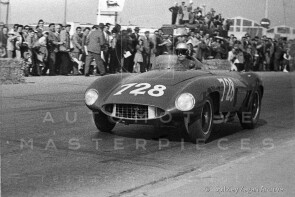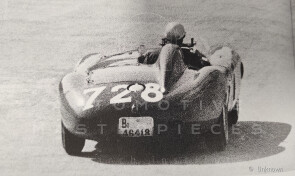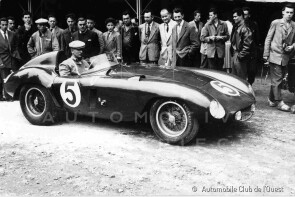
1955 Ferrari 735 LM
ON/OFF
Why am I an Automotive Masterpiece?
H. Works cars
Scuderia Ferrari - Modena (IT)
L. Limited edition cars
no. 4 manufactured
The first car from the Maranello-based company not designed around a 12-cylinder engine was the 500 F2 single-seater of 1951, which enabled Alberto Ascari to win the World Championship in both 1952 and 1953. During those years, due to a shortage of participants, Formula 2 cars were also allowed to compete in the premier Formula 1 championship. The 2-liter four-cylinder engine was another project by engineer Aurelio Lampredi, and the car proved unbeatable. The excellent performance of the inline four-cylinder engines encouraged Ferrari to experiment with this configuration in sports cars. Thus, in June 1953, derived from the 625 F1 single-seater, the 625 TF model debuted, almost indistinguishable from the contemporary 250 MM with V12 engine. The evolution of this model was the 735 S, equipped with a 3-liter engine and a transaxle gearbox. However, this phase at Maranello should still be considered experimental, leading up to the debut of the new 500 Mondial. The new 2-liter sports car marked the beginning of a productive collaboration between Carrozzeria Scaglietti and Maranello. The car proved fast and agile thanks to its light weight, achieving significant results. These qualities were further enhanced in 1954 with the introduction of the 3-liter model, also designed for the closed-wheel Sports category, the 750 Monza, named in honor of its victorious debut at the Monza circuit. The cycle of Ferrari's four-cylinder Sports cars concluded in 1957 with the 500 TRC. In the meantime, however, this family of cars inspired the development of a closely related series, featuring an additional two cylinders. These ongoing developments were in direct response to Mercedes storming back onto the racing world with the introduction of the legendary SLR.
Ferrari's inline-six-cylinder engine remains an intriguing anomaly in the brand's history, given its dominance in motorsport with V12, four-cylinder, and Dino V6 engines. Within this context, the existence of a Ferrari inline six-cylinder engine is often unexpected. In 1954, Aurelio Lampredi, using the 2-liter inline-four engine from the 500 Mondial as a foundation, developed Ferrari's first inline six-cylinder engine, designated as 306S. This engine remained a prototype and never saw practical use. However, it marked the beginning of a new direction in Ferrari's engineering, leading Lampredi to produce two additional inline-six engines shortly thereafter: a 3.7-liter variant derived from the 500 Mondial engine and a 4.4-liter version based on the 750 Monza. Accredited sources confirm that only four cars were equipped with these engines, all built in 1955, with chassis numbers 0484LM, 0532LM, 0546 LM, and 0558LM. During that year's racing season, all four vehicles—racing for Scuderia Ferrari—were upgraded from the original 3.7-liter engine to the 4.4-liter unit. The initial version of these cars was called the 376 S, where the first two digits represented the engine's displacement and the third indicated the number of cylinders. The upgraded version was named 735 LM, with "735" denoting the displacement of a single cylinder—following Ferrari's early naming tradition—and "LM" signifying its preparation for the 1955 24 Heures du Mans. Three cars were built for this race, with the fourth chassis being updated later. Despite the small production run and limited racing appearances—all for the factory team in 1955—the historical identification of these cars is challenging. Confusion arises primarily due to inconsistent naming, with unofficial designations like "118 LM" for the 376 S or "121 LM," "446 S," and "735 6C" for the 735 LM being commonly used. Additionally, these models were externally very similar to the 750 Monza, making them hard to distinguish. Lastly, period records and bibliographies often disagree on the specific races in which each chassis competed and the total number of events. The tubular Gilco chassis used for the 376 S/735 LM, similar to that of the 500 Mondial/750 Monza, was lengthened by 150 mm—from 2250 mm to 2400 mm—after the cars’ initial races in Argentina in January 1955. The bodywork was designed and built by Scaglietti. These cars participated in eight events in the Sports car category under the Scuderia Ferrari banner during the 1955 season, as reported by period press and credible bibliographies. The 376 S debuted at the 1000 Km of Buenos Aires, followed by the Gran Premio Ciudad de Buenos Aires. Their first success came at the Giro di Sicilia. They subsequently competed in the Mille Miglia, the Gran Premio di Bari, and the Eifelrennen Nürburgring. By the time of the 24 Heures du Mans, the model had evolved into the 735 LM. The final race for these cars under Ferrari's factory team was the Sveriges Grand Prix in Kristianstad. Like other Ferrari barchettas, these six-cylinder cars faced stiff competition, particularly from the dominant Mercedes-Benz 300 SLR. Their remarkable speed allowed them to win the Giro di Sicilia, set speed records at the Mille Miglia, and secure pole position at Le Mans. However, despite efforts to enhance their performance—including increasing engine displacement, adopting Englebert racing tires, and fitting larger fuel tanks—the cars achieved only modest success. It should also be noted that circumstances were not favorable: the tragedy at the 1955 Le Mans and the subsequent restrictions on engine size for the race led Ferrari to discontinue development and retire these cars from official competition by the end of 1955. Over time, each of the four 735 LM Scuderia Ferrari cars was sold to private customers or racing teams to continue their competitive careers. Remarkably, all four vehicles have survived to the present day.
The Ferrari sport car, chassis 0546LM, began its life as a 376 S model in early 1955 and debuted in competition on April 4, 1955, at the Giro di Sicilia. This was as part of the official Scuderia Ferrari team, racing with the number #438. Expert driver Piero Taruffi claimed the model’s first victory, an outstanding 1st overall and 1st in class. Taruffi’s precision and skill shone at the Giro di Sicilia, a technically demanding race that required both speed and meticulous car management. Known for his engineering background and scientific approach, Taruffi exploited every technical advantage of the Ferrari 0546LM, particularly its extended chassis and balanced weight distribution. A key moment occurred in the mountainous sections, where many rivals in more powerful cars lost ground on tight corners and steep descents, while Taruffi maintained a steady, high pace thanks to the car’s agility. Famous for preserving his engine and tires, Taruffi employed a strategy of accelerating on straights and pacing climbs, which kept the car in excellent condition. This approach secured not only his victory but also reinforced the reliability of the developing 376 S model. After the race, Taruffi and the Ferrari were celebrated by the Sicilian press and public, who nicknamed the car the "silver arrow of Maranello" for its speed and elegance. The win was crucial for Ferrari, showcasing the potential of the inline-six engine as a viable alternative to the iconic V12. Later that month, the Taruffi–chassis no. 0546LM pairing appeared at the Mille Miglia, racing with license plate PROVA BO46419.Ferrari started him last, at number 728, to give him an advantage. Taruffi set an outright, never-to-be-broken record in the first half of the race, surpassing the seemingly unbeatable Moss, who had established an incredible average speed of 187.315 km/h. Taruffi managed to average an even more astonishing pace of 189.909 km/h on the Brescia – Pescara leg on ancient roads, despite stops for refueling and other challenges. Unfortunately, he was forced to withdraw due to a mechanical failure shortly after Rome, before Siena. A detailed analysis of the car’s racing history has shed light on one of the main reasons why sources disagree about this participation in the Mille Miglia. The confusion stems from the registration documents for the four Scuderia Ferrari cars, which initially assigned them to different drivers about 20 days before the race. Subsequent circumstances, as documented in period press coverage, led to changes in these assignments. As a result, the Mille Miglia registration documents do not align with the cars and crews that actually raced. There was no doubt, however, about chassis no. 0546 LM’s participation in the 24 Heures du Mans in June: all sources agree that Ferrari 0546LM was the car competing with racing number #5, and extensive documentation regarding the car’s registration at Le Mans provided a wealth of detail. The Scuderia Ferrari’s 735 LM cars appeared very similar to each other, and even the two 750 Monza cars participating shared aerodynamic features with the 735 LM models. As a result of meticulous research through the Automobile Club de L’Ouest, located at the Circuit des 24 Heures in Le Mans, which houses the historical archive of the competition, it was possible to trace and obtain an authenticated copy of the registration sheet for chassis no. 0546 LM. Pre-race tests took place on June 8, 9, and 10, 1955, while the race occurred between June 11 and 12. The complete documentation of the car’s registration comprises nine pages, filled out on Wednesday, June 8, with a scheduled technical inspection at 5:30 p.m. On this occasion, the car presented itself for inspection around 5:00 p.m. and was verified. The registration details certify the chassis no. 0546 LM—together with its matching engine no. 0546 LM—providing an exhaustive list of technical specifications, mechanical components, and the Ferrari team members supporting the car. This document thus confirms the car’s identity at that precise historical moment. Alongside this meticulous documentation, chassis no. 0546LM is identifiable through an extensive photographic record from the period, stored in numerous historical archives. These photos capture key features such as the race number #5 on its bodywork and the rear plate "PROVA MO-49." Thanks to this combination of documents and photographs, it has been possible to definitively identify the unique features and recognizability of Ferrari chassis no. 0546LM at the 1955 24 Heures du Mans and thus confirm the car’s exact identity. Despite the aforementioned similarity among the four cars, as many as 20 unique elements were identified. Among these, particularly significant and revealing were details concerning the position of the badges, unique features of the dashboard, the hood latch hooks, the seat positioning, and the shape and number of air intakes. These unique features, traced back through time, were cross-referenced with the car’s prior appearances in the Giro di Sicilia and Mille Miglia, further validating its participation in these races. Chassis no. 0546LM was therefore both a protagonist and a witness to two of the most significant events in motorsport history, both of which occurred in 1955: Stirling Moss's iconic victory at the Mille Miglia, often hailed as the greatest feat in motor racing history, and the immense tragedy at the 1955 Le Mans, which forever changed the landscape of the sport. The car, driven by Maurice Trintignant and Harry Schell, started the 24 Heures du Mans but, despite its impressive speed, it withdrew during the tenth hour due to engine issues. At the end of the 1955 season, chassis no. 0546LM was sold to William Doheny, CEO of Superior Oil Company, who supported Ernie McAfee as its driver. 0546LM is recognizable as such also because Ernie McAfee's car, racing with number 76 at the Santa Barbara event, shows slight damage to one of the exhaust manifolds—damage that was already present on car #5 during the 1955 24 Heures du Mans. This, along with another key detail, confirms the historical continuity of chassis 0546LM and its engine throughout the 1955 season with Scuderia Ferrari and after its sale to private customer William Doheny. In particular, the engine bay—and especially the bulkhead—of the car in its appearances as #438 at the Giro di Sicilia, #728 at the Mille Miglia, #5 at Le Mans, and later at the Ernie McAfee Shop in November 1955, displays the same reinforcement ribs and drilled holes in exactly the same positions. In late 1955 and early 1956, the car achieved multiple podiums in California’s street and airfield races. Tragedy struck at Pebble Beach in April 1956 when McAfee lost control during the Del Monte Trophy race, crashing into a tree and losing his life. This incident led to the permanent ban on racing at Pebble Beach. Doheny restored the car over two years, retaining its matching-numbers engine and gearbox but overlooking the chassis stamping. The car remained in his family for two decades and was driven at the inaugural Monterey historic races in 1974. In 1975, it was purchased by Bill Ziering, who showcased it at events like the Pebble Beach Concours d’Elegance in 1975 and 1976. After changing hands through Bill Noon and Todd Morici in the late 1990s, it was auctioned by RM Sotheby’s in 2017. In 2018, the car underwent a meticulous restoration by the factory in Maranello, completed in 2023. It was returned to its original red livery, mechanical components were overhauled, and the lost chassis stamp reinstated. Certified by Ferrari Classiche, it was auctioned again in 2023, being sold to a private collection and participated in the 2024 Mille Miglia reenactment. On December 17, 2024, Scuderia Ferrari bid a heartfelt farewell to F1 driver Carlos Sainz Jr., marking the end of his four-year chapter with the team. While preparing for his transition to Williams, Sainz and his family celebrated an emotional day at Ferrari’s historic Fiorano track. The two Sainz, Carlos Jr. and his father Carlos Sr., drove both the modern F1-75 and the 735 LM, chassis no. 0546LM, as a tribute to the rich history and enduring legacy of the Prancing Horse.





